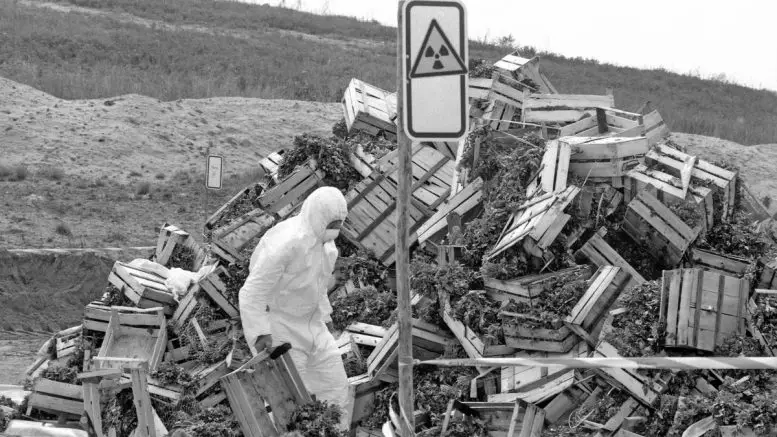April 26, 1986 began like any other day for the Soviet citizens of Pripyat, a little-known city of 50,000 in the Ukrainian SSR. At the nearby Chernobyl nuclear power plant, however, an insufficiently supervised experiment was already spiraling out of control. As Pripyat awoke, firefighters and plant workers were frantically trying to extinguish a fire in Reactor 4’s graphite core, which was spewing massive amounts of radioactive particles into the air. For two days, the Soviet Union maintained silence on the catastrophe. When the Soviet government finally disclosed the incident to its people and the world, several Scandinavian states had already detected radiation and an evacuation was underway in Pripyat. Over the ensuing decades, the accident would prove responsible for the evacuation of over 300,000 people, thousands of deaths, and the contamination of large swaths of present-day Ukraine, Belarus, and Russia.
This paper endeavors to show that while Pripyat suffered, the Soviet Union and the United States fought to control the story. In light of what contemporary commentators have described as an information war between Russia and the United States over the narrative of the war in eastern Ukraine, this paper recalls the long history of conflict between the two countries in the media sphere. As a comparison of coverage by the Soviet papers Izvestia and Pravda and The New York Times in Chernobyl’s immediate aftermath reveals, Soviet and Western narratives of the tragedy differed drastically, as each side sought a strategic advantage. While the Soviet reporters tried to downplay the incident and deflect its gravity with criticisms of the United States, even as their own comrades unwittingly absorbed radiation, Western news services seized the opportunity to shame the Soviets for the incident. Even in the midst of the worst nuclear disaster in world history, geopolitical posturing ruled the day.
The Soviet Union first acknowledged the situation at Chernobyl tersely. On April 30, Izvestia reported in a four-sentence release, “An accident has occurred at the Chernobyl Atomic Power Station. Measures are being taken. Aid is being given to the victims. A government commission has been established.”[1] At this point, a full two days after the tragedy began and after dozens of firefighters and operators had already been exposed to lethal doses of radiation, the Soviet press endeavored to project calm and order. While Pripyat prepared to evacuate, Izvestia reported only the most rudimentary information. From an everyday Soviet citizen’s perspective, without further information, this event at Chernobyl must have seemed like a routine issue, not the worst nuclear meltdown to date.
While those familiar with the cloistered Soviet system might recognize positive effects of Gorbachev’s glasnost in Izvestia’s willingness to touch on the issue at all, the New York Times’first report suggests a different reality. “The [Soviet] announcement,” the paper wrote, “came hours after Sweden, Finland, and Denmark reported abnormally high radioactivity levels in their skies.”[2] The Soviet press release, the Times suggested, was not intended to inform nearby residents or those with relatives in the area, but simply to alleviate international concern “after Sweden had demanded information.”[3]
Sensing Soviet weakness, the Times used the brief statement to further embarrass America’s archrival. Rather than focus on Soviet willingness to disclose a disaster in the period of glasnost, the Times article reminded readers of “at least two previous mishaps” unacknowledged in the Soviet Union, one nuclear plant incident in 1957 and a second in 1974. Referencing a TASS report that followed the Soviet Union’s initial statement and focused on nuclear accidents in the United States, the Times article concluded with a broad condemnation of Soviet policy: “The practice of focusing on disasters elsewhere when one occurs in the Soviet Union is so common that after watching a report on Soviet television about a catastrophe abroad, Russians often call Western friends to find out whether something has happened in the Soviet Union.”[4] Reading between the lines of the terse Izvestia statement, the Western press focused on the USSR’s international and domestic irresponsibility in not disclosing the incident, and sought to score a political victory.
As Chernobyl’s nuclear core burned and information dispersed across the globe, Soviet and Western appraisals of the disaster continued to diverge. After the evacuation of Pripyat on April 27, the Soviet side continued to project that they had taken control over the situation, a feat made possible by the heroic efforts of fallen comrades, and blamed the West for inciting panic. On May 6, ten days after the accident, Pravda published its first detailed report on Chernobyl, which primarily chronicled the struggle to contain the fire in Reactor 4. “It was hard to breathe because of the soot and smoke, but the courageous fellows bravely fought on,” the paper eulogized.[5] The firefighters, many not told the danger they were about to confront,[6] were “a model of the performance of one’s official duties.”[7] Their heroism yielded calm in what Pravda described as “a complicated and extraordinarily difficult, but controllable, situation.”[8] Admitting there were “isolated cases of individuals panicking,” Pravda reassured the Soviet people that “to the credit of the thousands of people who work at the atomic power station, and those who live nearby, there was no panic.”[9]
The Pravda report also jumped at the opportunity to rebuke the West for, in their view, disseminating misinformation and reveling in Soviet misery. According to the report, “certain foreign wire sources” were to blame for what panic did exist and were spreading rumors of thousands of deaths and a “general irradiation of almost the entire European part of the country.”[10] Sensing that the West was tallying Chernobyl as a public opinion victory, Pravdaasked, “What can be more shameful than gloating over a misfortune?”[11] While hindsight would justify the western media’s concern for the victims, immediately after the accident, Pravda found it expedient to focus only on the heroism of their comrades, and to fully ignore the real danger posed to and the suffering caused to citizens, and to deflect notions of the event’s massive scope as Western hyperbole.
In Chernobyl’s aftermath, Western news sources exhibited a decidedly more apocalyptic tone. Four days after the event, the New York Times claimed in its first in-depth analysis since the accident’s disclosure, “Most experts agreed that the graphite core of the Chernobyl reactor…had caught fire and was burning fiercely.”[12] Further, the Times used the situation to invoke a broader comparison of nuclear safety in the USSR and the United States. Quoting the notable Soviet dissident Zhores Medvedev, the Times replaced Pravda’s portrayal of calm with a depiction of Pripyat in danger: “Apparently there were no emergency measures in the area, no broadcasts, and no emergency plans to deal with a situation like this.”[13] A second New York Times article on May 1 wrote, in sharp contrast with Soviet statements, “Some [U.S.] officials said the site at Chernobyl had apparently been so heavily contaminated by radioactive material that it would be difficult for the workers to bring the accident under control.”[14]
A criticism of the Soviet Union’s preparedness to deal with such an accident, however, would not be complete without the suggestion that the United States would be more prepared. Attempting to dispel concern that Chernobyl was perhaps possible in America – recall that the near-catastrophe at Three Mile Island occurred just six years before – the Times wrote, “the Soviet reactor lacked a containment building of the kind that kept radioactive gasses contained at Three Mile Island.”[15] Under the sub header “Soviet Technology Faulted,” the paper reported that “the stricken reactor was not encased in a protective concrete containment dome, as is customary in the United States.”[16] In the sciences, the Cold War sparked a race for each side to prove that it had the most technological successes; in the press, the Cold War incited a competition to prove that the other side’s technological failures were worse.
The Soviet press promptly fired back at the Western version of events. If the Soviet Union’s previous statements represented volleys in the battle to control the Chernobyl story, on May 5, Izvestia declared war. Using data from the American anti-nuclear watchdog group Public Citizen, the paper attempted to deflect attention from Chernobyl by exposing atomic energy accidents in the West, though none of these caused damage comparable to what had already been wrought in Pripyat. “About 20,000 accidents and problems of various sorts have occurred at American atomic power stations since 1979,” and the number was “growing year by year.”[17] Three Mile Island, still fresh in the public’s mind, drew particular criticism: “at that time, a ‘strong leakage of radioactivity’ occurred, traces of which were registered over a very large area, as far away as the state of Maine.”[18] The logical implication follows that atomic power is unsafe only in the irresponsible West. At the same time, however, the Soviet press found excuses for their own catastrophe: “Atomic power engineering as a technology is young.”[19] This would prepare the groundwork for the finale in Pravda the following day. “All this,” opined Soviet political commentator Yury Zhukov, referring to U.S. concern and speculation over Chernobyl, “is being done to divert attention from criminal, aggressive actions by the United States, like the recent bombing of Libya.”[20] Perusing the Soviet press one week after the meltdown, one would wonder whether the disaster took place in the United States or the Soviet Union.
As Soviet heroes fought to extinguish the blaze in Reactor 4, the Soviet Union and the West were already fighting to control the Chernobyl story. On the Soviet side, this meant downplaying fears, countering criticism with condemnations of the West, and deflecting foreign concern as self-interested rumormongering. Western reporting bias was admittedly subtler. Nonetheless, the first stories in the Western press attempted to depict a dire situation, shame the Soviets for their initial silence, and create a comparison of nuclear technologies favorable to America. The animosity between the USSR and the United States never provoked the superpowers into nuclear war. In Chernobyl’s immediate aftermath, however, the two countries fought bitterly in the information sphere over the narrative of the worst nuclear disaster in history.
Works Cited
Boffey, Philip. “Intelligence Sources Say Accident Began Days Ago,” New York Times, April 30, 1986. Proquest Historical Newspapers.
“Chernobyl: Seconds From Disaster,” National Geographic, http://channel.nationalgeographic.com/videos/meltdown-in-chernobyl
Gwetzman, Bernard, “More European Nations Report Finding Proof of Radioactivity,” New York Times, May 1, 1986, ProQuest Historical Newspapers.
“Nuclear Reactor Damaged,” Izvestia, April 30, 1986, translated and reprinted in The Current Digest of the Soviet Press, 38 no. 16 (May 21, 1986)
Oberg, James E. Uncovering Soviet Disasters: Exploring the Limits of Glasnost. New York: Random House, 1988.
“Pravda Reporters Give Details of Explosion, Fire at Reactor 4,” Pravda, May 6, 1986, translated and reprinted in The Current Digest of the Soviet Press, 38, no.17 (May 28, 1986).
“Public Citizen Quoted on Numerous Accidents at U.S. Nuclear Power Stations,” Izvestia, May 5, 1986, translated and reprinted in The Current Digest of the Soviet Press 38, no.18 (June 4, 1986).
Schmemann, Serge. “Soviet Union Announces Nuclear Accident at Electric Plant,” New York Times. April 29, 1986. Proquest Historical Newspapers.
Schmemman, Serge. “Chernobyl Answers: New Questions.” New York Times, July 21, 1986. Proquest Historical Newspapers.
“Zhukov: ‘Provocative Campaign’ by U.S. to Magnify Disaster Denounced,” Pravda, May 6, 1986, translated and reprinted in condensed form in The Current Digest of the Soviet Press, 38, no.18 (June 4, 1986).
Footnotes


